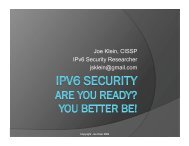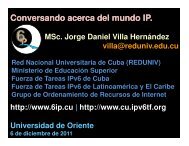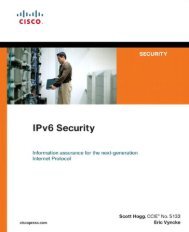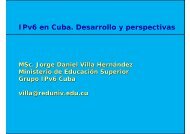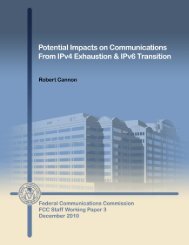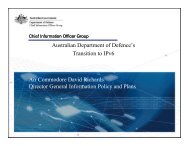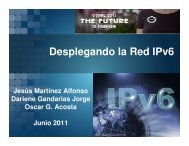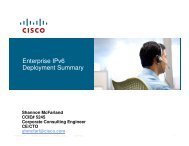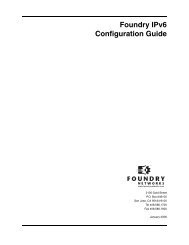Address
Address
Address
You also want an ePaper? Increase the reach of your titles
YUMPU automatically turns print PDFs into web optimized ePapers that Google loves.
IPv6 ConceptsRST-1300RST-130012394_04_2006_c2© 2006 Cisco Systems, Inc. All rights reserved. Cisco Public1
Why IPv6?RST-130012394_04_2006_c2© 2006 Cisco Systems, Inc. All rights reserved. Cisco Public2
A Need for IPv6?• IETF IPv6 WG began in early 90s, to solveaddressing growth issues, butCIDR, NAT,…were developed• IPv4 32 bit address = 4 billion hosts~40% of the IPv4 address space is still unused which isdifferent from unallocatedThe rising of Internet connected device and appliance willeventually deplete the IPv4 address space• IP is everywhereData, voice, audio and video integration is a realityRegional registries apply a strict allocation control• So, only compelling reason: More IP addressesRST-130012394_04_2006_c2© 2006 Cisco Systems, Inc. All rights reserved. Cisco Public3
A Need for IPv6?• Internet population~600M users in Q4 CY’01, ~945M by end CY’04—only 10–15% of the totalpopulationHow to address the future worldwide population? (~9B in CY’50)Emerging Internet countries need address space, e.g.,China uses nearly two class A (11/2001), ~20 class A needed if every student (320M) has to getan IP address• Mobile Internet introduces new generation of Internet devicesPDA (~20M in 2004), mobile phones (~1.5B in 2003), tablet PCEnable through several technologies, e.g., 3G, 802.11, etc.• Consumer, home and industrial appliancesRST-130012394_04_2006_c2© 2006 Cisco Systems, Inc. All rights reserved. Cisco Public4
A Need for IPv6?• Transportation—mobilenetworks1B automobiles forecast for 2008—begin now on vertical marketsInternet access on planes, e.g.Lufthansa—train, e.g. Narita express• Travelers flying on Lufthansafrom Frankfurt, Germany toWashington, DC were amongthe first to try high-speedInternet access at 35,000 feet.The Boeing 747-400 jetequipped with a broadbandnetwork is esteemed to be themodel for commercial airlinetravel in the future.RST-130012394_04_2006_c2© 2006 Cisco Systems, Inc. All rights reserved. Cisco Public5
IP <strong>Address</strong> Allocation History1981 ~ IPv4 Protocol Published1985 ~ 1/16 of Total Space1990 ~ 1/8 of Total Space1995 ~ 1/3 of Total Space2000 ~ 1/2 of Total Space2001.5 ~ 2/3 of Total Space100%90%80%70%60%50%40%30%20%10%0%1980 1985 1990 1995 2000 2005 2010• This despite increasingly intense conservation effortsPPP/DHCP address sharingCIDR (classless inter-domain routingNAT (network address translation)plus some address reclamation• Theoretical limit of 32-bit space: ~4 billion devicesPractical limit of 32-bit space: ~250 million devices (RFC 3194)RST-130012394_04_2006_c2© 2006 Cisco Systems, Inc. All rights reserved. Cisco Public6
Coming Back to an End-to-End ArchitectureNew Technologies/Applications for Home Users“Always-On”—Cable, DSL, Ethernet-to-the-Home, Wireless, etc.• Internet started withend-to-end connectivityfor any applications• Today, NAT andApplication-LayerGateways connectdisparate networks• Always-on devices needan address when youcall them:Mobile phonesGamingResidential Voice over IPgatewayIP faxGlobal<strong>Address</strong>ingRealmRST-130012394_04_2006_c2© 2006 Cisco Systems, Inc. All rights reserved. Cisco Public7
Why Not NAT• Exhaustion of address space• NAT breaks the end-to-end model• Growth of NAT has slowed down growth oftransparent applications• No easy way to maintain states of NAT in case ofnode failures• NAT break security• NAT complicates mergers, double NATing isneeded for devices to communicate with each otherRST-130012394_04_2006_c2© 2006 Cisco Systems, Inc. All rights reserved. Cisco Public8
IP—The Application’s Convergence LayerWith Millions of New Devices Becoming IP Aware,the Need for Increased <strong>Address</strong>ing and Plug-and-Play NetworkingIs Only Met with the Implementation of IPv6IP Version 6StorageChannelCATVE-PowerWirelessOpticalEthernetxDSLPSDNMore toComeRST-130012394_04_2006_c2© 2006 Cisco Systems, Inc. All rights reserved. Cisco Public9
IPv6 TechnologyRST-130012394_04_2006_c2© 2006 Cisco Systems, Inc. All rights reserved. Cisco Public10
IPv6 Features• Larger address space enabling:Global reachability, flexibility, aggregation, multihoming,autoconfiguration, “plug and play” and renumbering• Simpler header enabling:Routing efficiency, performance and forwarding ratescalability• Improved option support• Mandated security (global key yet to be defined)• Transition richnessRST-130012394_04_2006_c2© 2006 Cisco Systems, Inc. All rights reserved. Cisco Public11
IPv4 and IPv6 Header ComparisonVersionIHLTime to LiveIdentificationIPv4 HeaderType ofServiceProtocolFlagsTotal LengthFragmentOffsetHeader ChecksumVersionTrafficClassPayload LengthIPv6 HeaderFlow LabelNextHeaderHop LimitSource <strong>Address</strong>Destination <strong>Address</strong>OptionsPaddingSource <strong>Address</strong>LegendField’s Name Kept from IPv4 to IPv6Fields Not Kept in IPv6Name and Position Changed in IPv6New Field in IPv6Destination <strong>Address</strong>RST-130012394_04_2006_c2© 2006 Cisco Systems, Inc. All rights reserved. Cisco Public12
The Chain of Pointers Formed by the NextHeader FieldIPv6 HeaderNext Header = 6(TCP)TCP SegmentIPv6 HeaderNext Header = 43(Routing)Routing HeaderNext Header = 6(TCP)TCP SegmentIPv6 HeaderNext Header = 43(Routing)Routing HeaderNext Header = 51(AH)Authentication HeaderNext Header = 6(TCP)TCP SegmentRST-130012394_04_2006_c2© 2006 Cisco Systems, Inc. All rights reserved. Cisco Public14
IPv6 Protocol• New field• Flow label (RFC3697)Sequence of packets for which a source desires tolabel a flowFlow classifiers have been based on 5-tuple:source/destination address, protocol type and portnumbers of transportSome of these fields may be unavailable due tofragmentation, encryption or locating them past extensionheaders.In IPv6: Only 3 tuple, flow label, source/destination addressRST-130012394_04_2006_c2© 2006 Cisco Systems, Inc. All rights reserved. Cisco Public15
MTU Issues• Minimum link MTU for IPv6 is 1280 octets(vs. 68 octets for IPv4)=> on links with MTU < 1280, link-specificfragmentation and reassembly must be used• Implementations are expected to perform path MTUdiscovery to send packets bigger than 1280• Minimal implementation can omit PMTU discoveryas long as all packets kept ≤ 1280 octets• A hop-by-hop option supports transmission of“jumbograms” with up to 2 32 octets of payloadRST-130012394_04_2006_c2© 2006 Cisco Systems, Inc. All rights reserved. Cisco Public16
<strong>Address</strong>ingRST-130012394_04_2006_c2© 2006 Cisco Systems, Inc. All rights reserved. Cisco Public17
Larger <strong>Address</strong> SpaceIPv4 = 32 BitsIPv6 = 128 Bits• IPv4• IPv632 bits=~ 4,200,000,000 possible addressable nodes128 bits= 340,282,366,920,938,463,463,374,607,431,768,211,456 nodesRST-130012394_04_2006_c2© 2006 Cisco Systems, Inc. All rights reserved. Cisco Public18
<strong>Address</strong>ingRepresentation• 16-bit hexadecimal numbers• Numbers are separated by (:)• Hex numbers are not case sensitive• Abbreviations are possibleLeading zeros in contiguous block could be represented by(::)Example:2001:0db8:0000:130F:0000:0000:087C:140B2001:0db8:0:130F::87C:140BDouble colon only appears once in the addressRST-130012394_04_2006_c2© 2006 Cisco Systems, Inc. All rights reserved. Cisco Public19
<strong>Address</strong>ingPrefix Representation• Representation of prefix is just like CIDR• In this representation you attach the prefix length• Like v4 address:198.10.0.0/16• V6 address is represented the same way:2001:db8:12::/40RST-130012394_04_2006_c2© 2006 Cisco Systems, Inc. All rights reserved. Cisco Public20
IPv6—<strong>Address</strong>ing Model• <strong>Address</strong>es are assigned to interfacesChange from IPv4 mode:• Interface “expected” to have multiple addresses• <strong>Address</strong>es have scopeLink LocalUnique LocalGlobal Unique Local Link LocalGlobal• <strong>Address</strong>es have lifetimeValid and preferred lifetimeRST-130012394_04_2006_c2© 2006 Cisco Systems, Inc. All rights reserved. Cisco Public21
<strong>Address</strong>ing• Some special addressesType Binary HexAggregatable GlobalUnicast <strong>Address</strong>Link Local Unicast<strong>Address</strong>Unique LocalUnicast <strong>Address</strong>0010 21111 1110 10 FE80::/101111 11001111 1101FC00::/8FD00::/8Multicast <strong>Address</strong> 1111 1111 FF00::/16RST-130012394_04_2006_c2© 2006 Cisco Systems, Inc. All rights reserved. Cisco Public22
Types of IPv6 <strong>Address</strong>es• Unicast<strong>Address</strong> of a single interface. One-to-one delivery to singleinterface• Multicast<strong>Address</strong> of a set of interfaces. One-to-many delivery to allinterfaces in the set• Anycast<strong>Address</strong> of a set of interfaces. One-to-one-of-many deliveryto a single interface in the set that is closest• No more broadcast addressesRST-130012394_04_2006_c2© 2006 Cisco Systems, Inc. All rights reserved. Cisco Public23
Aggregatable Global Unicast <strong>Address</strong>esProvider Site Host3 45 Bits 16 Bits64 BitsGlobal Routing Prefix SLA Interface ID001Aggregatable Global Unicast <strong>Address</strong>es Are:• <strong>Address</strong>es for generic use of IPv6• Structured as a hierarchy to keep the aggregationRST-130012394_04_2006_c2© 2006 Cisco Systems, Inc. All rights reserved. Cisco Public24
Hierarchical <strong>Address</strong>ing and AggregationSubnet Prefix65,536 Subnets2001:0DB8:0001:0002::/64Site Prefix65,536 Sites2001:0DB8:0001::/48ISP Prefix512 ISPs2001:0DB8::/322001 0DB8 0001 0002 Interface ID (64 Bits)20010 0 0 0 1 1 0 1 1 0 1 1 1 0 0 0RST-130012394_04_2006_c2Registry2001:0C00::/23© 2006 Cisco Systems, Inc. All rights reserved. Cisco Public25
Hierarchical <strong>Address</strong>ing and AggregationSite 12001:DB8:0001:/482001:DB8:0001:0001:/642001:DB8:0001:0002:/642001:DB8:0002:0001:/642001:DB8:0002:0002:/64Site 22001:DB8:0002:/48Announcesthe /64 PrefixAnnouncesthe /48 PrefixISP2001:DB8::/32Announcesthe /48 PrefixAnnouncesthe /32 PrefixIPv6 Internet2001::/16RST-130012394_04_2006_c2© 2006 Cisco Systems, Inc. All rights reserved. Cisco Public26
IPv6 Interface IdentifierLowest-Order 64-Bit Field of Unicast <strong>Address</strong>May Be Assigned in Several Different Ways:• Auto-configured from a 64-bit EUI-64, or expandedfrom a 48-bit MAC address (e.g. Ethernet address)• Auto-generated pseudo-random number(to address privacy concerns)• Assigned via DHCP• Manually configuredRST-130012394_04_2006_c2© 2006 Cisco Systems, Inc. All rights reserved. Cisco Public27
IPv6 Interface Identifier• Cisco uses the EUI-64 format to do stateless autoconfiguration• This format expands the 48 bit MAC address to 64bits by inserting FFFE into the middle 16 bits• To make sure that the chosen address is froma unique Ethernet MAC address, theuniversal/local (“u” bit) is set to 1 for global scopeand 0 for local scopeRST-130012394_04_2006_c2© 2006 Cisco Systems, Inc. All rights reserved. Cisco Public28
IEEE EUI-64 <strong>Address</strong>es• Extended Unique Identifier (EUI)• Company ID - Extension ID• U/L bit (u)Universally (=0)/Locally (=1) Administered• U/G bit (g)Unicast (=0)/Group (=1) <strong>Address</strong>24 bits 40 bitsccccccug cccccccc ccccccccIEEE-administered company IDxxxxxxxx xxxxxxxx xxxxxxxx xxxxxxxx xxxxxxxxManufacturer-selected extension IDRST-130012394_04_2006_c2© 2006 Cisco Systems, Inc. All rights reserved. Cisco Public29
Conversion of an IEEE 802 <strong>Address</strong> to anEUI-64 <strong>Address</strong>IEEE-administered company IDManufacturer-selected extension ID24 bits 24 bitsIEEE 802<strong>Address</strong>ccccccug cccccccc ccccccccxxxxxxxx xxxxxxxx xxxxxxxxccccccug cccccccc cccccccc11111111 11111110xxxxxxxx xxxxxxxx xxxxxxxxEUI-64 <strong>Address</strong>0xFF0xFERST-130012394_04_2006_c2© 2006 Cisco Systems, Inc. All rights reserved. Cisco Public30
Aggregatable Global Unicast <strong>Address</strong>esEUI-64Ethernet MAC <strong>Address</strong>(48 Bits)64-Bits VersionUniqueness of the MACEui-64 <strong>Address</strong>00 90 27 17 FC 0F00 90 27 17 FC 0FFF FE00 90 27 FF FE 17 FC 0F1 = Unique000000U0 Where U=U = 10 = Not Unique02 90 27 FF FE 17 FC 0F• Eui-64 address: Insert “FFFE” in middle• Invert ‘U’ bit to identify uniqueness of MACRST-130012394_04_2006_c2© 2006 Cisco Systems, Inc. All rights reserved. Cisco Public31
Link-Local128 BitsRemaining 54 BitsInterface ID1111 1110 10FE80::/1010 BitsLink-Local <strong>Address</strong>es Used For:• Mandatory <strong>Address</strong> for Communication between two IPv6 device (Like ARPbut at Layer 3)• Automatically assigned by Router as soon as IPv6 is enabled• Also used for Next-Hop calculation in Routing Protocols• Only Link Specific scope• Remaining 54 bits could be Zero or any manual configured valueRST-130012394_04_2006_c2© 2006 Cisco Systems, Inc. All rights reserved. Cisco Public33
IPv6 Multicast <strong>Address</strong>• IP multicast address has a prefix FF00::/8(1111 1111). The second octet defines the lifetimeand scope of the multicast address.8-bit 4-bit 4-bit 112-bit1111 1111 Lifetime Scope Group-IDLifetime0 If Permanent1 If TemporaryScope1 Node2 Link5 Site8 OrganizationEGlobalRST-130012394_04_2006_c2© 2006 Cisco Systems, Inc. All rights reserved. Cisco Public34
IPv6 Multicast <strong>Address</strong>• The multicast address AllSPFRouters is FF02::5note that 02 means that this is a permanent addressand has link scope• The multicast address ALLDRouters is FF02::6RST-130012394_04_2006_c2© 2006 Cisco Systems, Inc. All rights reserved. Cisco Public35
Solicited-Node Multicast <strong>Address</strong>• For each unicast and anycast address configuredthere is a corresponding solicited-node multicast• This address is link local significance only• This is specially used for two purpose, for thereplacement of ARP, and DADRST-130012394_04_2006_c2© 2006 Cisco Systems, Inc. All rights reserved. Cisco Public36
Solicited-Node Multicast <strong>Address</strong>• Used in neighbor solicitation messages• Multicast address with a link-local scope• Solicited-node multicast consists of prefix + lower24 bits from unicast, FF02::1:FF:RST-130012394_04_2006_c2© 2006 Cisco Systems, Inc. All rights reserved. Cisco Public37
Router InterfaceR1#sh ipv6 int e0Ethernet0 is up, line protocol is upIPv6 is enabled, link-local address is FE80::200:CFF:FE3A:8B18No global unicast address is configuredJoined group address(es):FF02::1FF02::2Solicited-Node Multicast <strong>Address</strong>FF02::1:FF3A:8B18MTU is 1500 bytesICMP error messages limited to one every 100 millisecondsICMP redirects are enabledND DAD is enabled, number of DAD attempts: 1ND reachable time is 30000 millisecondsND advertised reachable time is 0 millisecondsND advertised retransmit interval is 0 millisecondsND router advertisements are sent every 200 secondsND router advertisements live for 1800 secondsHosts use stateless autoconfig for addresses.R1#RST-130012394_04_2006_c2© 2006 Cisco Systems, Inc. All rights reserved. Cisco Public38
AnycastAnycast <strong>Address</strong> Assignment• Routers along the path to the destination justprocess the packets based on network prefix• Routers configured to respond to anycast packetswill do so when they receive a packet send to theanycast address• Anycast allows a source node to transmit IPdatagrams to a single destination node out of agroup destination nodes with same subnet id basedon the routing metricsRST-130012394_04_2006_c2© 2006 Cisco Systems, Inc. All rights reserved. Cisco Public39
ICMPv6 and Neighbor DiscoveryRST-130012394_04_2006_c2© 2006 Cisco Systems, Inc. All rights reserved. Cisco Public40
ICMPv6• Internet Control Message Protocol version 6• RFC 2463• Modification of ICMP from IPv4• Message types are similar(but different types/codes)Destination unreachable (type 1)Packet too big (type 2)Time exceeded (type 3)Parameter problem (type 4)Echo request/reply (type 128 and 129)RST-130012394_04_2006_c2© 2006 Cisco Systems, Inc. All rights reserved. Cisco Public41
ICMPv6 Message Fields• Type—identifies the message or action needed• Code—is a type-specific sub-identifier. Forexample, Destination Unreachable can mean noroute, port unreachable, administrativelyprohibited, etc.• Checksum—computed over the entire ICMPv6message and prepended with a pseudo-headercontaining a single-octet• Next Header value of 58RST-130012394_04_2006_c2© 2006 Cisco Systems, Inc. All rights reserved. Cisco Public42
Neighbor Discovery• Replaces ARP, ICMP (redirects, router discovery)• Reachability of neighbors• Hosts use it to discover routers, auto configurationof addresses• Duplicate <strong>Address</strong> Detection (DAD)RST-130012394_04_2006_c2© 2006 Cisco Systems, Inc. All rights reserved. Cisco Public43
Neighbor Discovery• Neighbor discovery uses ICMPv6 messages,originated from node on link local with hoplimit of 255• Consists of IPv6 header, ICMPv6 header, neighbordiscovery header, and neighbor discovery options• Five neighbor discovery messages1. Router solicitation (ICMPv6 type 133)2. Router advertisement (ICMPv6 type 134)3. Neighbor solicitation (ICMPv6 type 135)4. Neighbor advertisement (ICMPv6 type 136)5. Redirect (ICMPV6 type 137)RST-130012394_04_2006_c2© 2006 Cisco Systems, Inc. All rights reserved. Cisco Public44
Neighbor DiscoveryRouter Solicitation• Host send to inquire about presence of a router onthe link• Send to all routers multicast address of FF02::2(all routers multicast address)• Source IP address is either link local address orunspecified IPv6 address (::)RST-130012394_04_2006_c2© 2006 Cisco Systems, Inc. All rights reserved. Cisco Public45
Router Solicitation and Advertisement1. RS2. RA1—ICMP Type = 133 (RS)Src = link-local address (FE80::/10)Dst = all-routers multicast address(FF02::2)Query = please send RA2—ICMP Type = 134 (RA)Src = link-local address (FE80::/10)Dst = all-nodes multicast address(FF02::1)Data = options, subnet prefix, lifetime,autoconfig flag• Router solicitations (RS) are sent by booting nodesto request RAs for configuring the interfacesRST-130012394_04_2006_c2© 2006 Cisco Systems, Inc. All rights reserved. Cisco Public46
Neighbor Solicitation• Send to discover link layer address of IPv6 node• For Layer 2 it is set to multicast for addressresolution, unicast for node reachability• IPv6 header, source address is set to unicastaddress of sending node, or :: for DAD• Destination address is set to the unicastaddress for reachability and solicited nodemulticast for DADRST-130012394_04_2006_c2© 2006 Cisco Systems, Inc. All rights reserved. Cisco Public47
Neighbor Advertisement• Response to neighbor solicitation message• Also send to inform change of link layer addressRST-130012394_04_2006_c2© 2006 Cisco Systems, Inc. All rights reserved. Cisco Public48
Neighbor Solicitation and AdvertisementABNeighbor Solicitation:ICMP type = 135Src = ADst = Solicited-node multicast address of BData = link-layer address of AQuery = what is your link-layer address?Neighbor Advertisement:ICMP type = 136Src = BDst = AData = link-layer address of BA and B Can Now ExchangePackets on This LinkRST-130012394_04_2006_c2© 2006 Cisco Systems, Inc. All rights reserved. Cisco Public49
Viewing Neighbors in the CacheNeighbors are only considered “reachable” for 30-seconds. “Stale” indicatesthat, before we contact this neighbor, we will need to send a ND packet.RST-130012394_04_2006_c2© 2006 Cisco Systems, Inc. All rights reserved. Cisco Public50
RedirectABR2R12001:db8:C18:2::/64Src = ADst IP = 2001:db8:C18:2::1Dst Ethernet = R2 (default router)Redirect:Src = R2Dst = AData = good router = R1• Redirect is used by a router to signal the reroute ofa packet to a better routerRST-130012394_04_2006_c2© 2006 Cisco Systems, Inc. All rights reserved. Cisco Public51
AutoconfigurationMac <strong>Address</strong>:00:2c:04:00:FE:56Host Autoconfigured<strong>Address</strong> Is:Prefix Received +Link-Layer <strong>Address</strong>Sends Network-TypeInformation(Prefix, Default Route, …)Larger <strong>Address</strong> Space Enables:• The use of link-layer addresses inside the address space• Autoconfiguration with “no collisions”• Offers “plug and play”RST-130012394_04_2006_c2© 2006 Cisco Systems, Inc. All rights reserved. Cisco Public52
RenumberingMac <strong>Address</strong>:00:2c:04:00:FE:56Host Autoconfigured<strong>Address</strong> Is:New Prefix Received+ Link-Layer <strong>Address</strong>Sends New Network-TypeInformation(Prefix, Default Route, …)Larger <strong>Address</strong> Space Enables:• Renumbering, using autoconfiguration and multipleaddressesRST-130012394_04_2006_c2© 2006 Cisco Systems, Inc. All rights reserved. Cisco Public53
IPv6 ConfigurationsRST-130012394_04_2006_c2© 2006 Cisco Systems, Inc. All rights reserved. Cisco Public54
IPv6 Configuration• In order to enable IPv6 the following globalcommand should be enteredRouter( config ) # ipv6 unicast-routing• To configure a global IPv6 or unique local IPv6 thefollowing command should be enteredRouter (config-if)# ipv6 address X:X::/prefix• Note that by configuring an IPV6 address you willhave a global or unique-local IPv6 address and alink-local IPv6 address which isFE80::interface-idRST-130012394_04_2006_c2© 2006 Cisco Systems, Inc. All rights reserved. Cisco Public55
IPv6 Configuration• The local-link IPv6 address is constructedautomatically by concatenating FE80 with InterfaceID as soon as IPv6 is enabled on the interface eitherby assigning an IPv6 address or simply by enteringthe commandRouter(config-if)# ipv6 enableRST-130012394_04_2006_c2© 2006 Cisco Systems, Inc. All rights reserved. Cisco Public56
IPv6 ConfigurationRouter#conf tRouter(config)#int fastEthernet 0/0Router(config-if)#ipv6 enableRouter#show ipv6 interface fastEthernet 0/0FastEthernet0/0 is up, line protocol is upIPv6 is enabled, link-local address is FE80::205:5FFF:FED3:6808No global unicast address is configuredJoined group address(es):FF02::1FF02::2FF02::1:FFD3:6808MTU is 1500 bytesICMP error messages limited to one every 100 millisecondsICMP redirects are enabledND DAD is enabled, number of DAD attempts: 1ND reachable time is 30000 millisecondsND advertised reachable time is 0 millisecondsND advertised retransmit interval is 0 millisecondsND router advertisements are sent every 200 secondsND router advertisements live for 1800 secondsHosts use stateless autoconfig for addresses.RST-130012394_04_2006_c2© 2006 Cisco Systems, Inc. All rights reserved. Cisco Public57
IPv6 ConfigurationR1E#sh ipv6 interfaceEthernet0/0 is up, line protocol is upIPv6 is enabled, link-local address is FE80::A8BB:CCFF:FE00:1E00Global unicast address(es):2001:DB8::A8BB:CCFF:FE00:1E00, subnet is 2001:DB8::/64 [EUI]Joined group address(es):FF02::1FF02::2FF02::1:FF00:1E00MTU is 1500 bytesICMP error messages limited to one every 100 millisecondsICMP redirects are enabledND DAD is enabled, number of DAD attempts: 1ND reachable time is 30000 millisecondsND advertised reachable time is 0 millisecondsND advertised retransmit interval is 0 millisecondsND router advertisements are sent every 200 secondsND router advertisements live for 1800 secondsHosts use stateless autoconfig for addresses.RST-130012394_04_2006_c2© 2006 Cisco Systems, Inc. All rights reserved. Cisco Public58
Cisco IOS Standard Access ListsWhen Used for Traffic Filtering, IPv6Standard Access Control Lists (ACL)Offers the Following Functions:• Can filter traffic based on source anddestination address• Can filter traffic inbound or outbound on aspecific interface• Can add priority to the ACL• Implicit “deny all” at the end of access listRST-130012394_04_2006_c2© 2006 Cisco Systems, Inc. All rights reserved. Cisco Public59
IPv6 Access-List Example• Filtering outgoing traffic from site-local sourceaddresses2001:0db8:c18:2::/64fc00:0:0:2::/64ipv6 access-list blocksite deny fc00:0:0:2::/64 anyipv6 access-list blocksite permit any anyinterface Ethernet0ipv6 traffic-filter blocksite outIPv6 InternetEthernet0Global prefix: 2001:0db8:c18:2::/64Site-local prefix: fc00:0:0:2::/64RST-130012394_04_2006_c2© 2006 Cisco Systems, Inc. All rights reserved. Cisco Public60
Troubleshooting Access-ListsRouter# show ipv6 access-listipv6 access-list floridadeny 2001:db8::/64 any priority 10permit 2001::/64 any priority 20permit any any priority 30Router#debug ipv6 packetIPv6 unicast packet debugging is on3d22h: IPV6: source FE80::210:7BFF:FEC7:38C0 (local)3d22h: dest FF02::1 (Ethernet0/0)3d22h: traffic class 112, flow 0x0, len 96+1404, prot 58, hops 255, originatingRouter#debug ipv6 ndICMP Neighbor Discovery events debugging is on3d22h: ICMPv6-ND: Sending RA to FF02::1 on Ethernet0/03d22h: ICMPv6-ND: prefix = 2001:ABCD:ABCD:1::/64 onlink autoconfig3d22h: ICMPv6-ND: Received RA from FE80::210:7BFF:FEC7:3440 on Ethernet0/0RST-130012394_04_2006_c2© 2006 Cisco Systems, Inc. All rights reserved. Cisco Public61
RoutingRST-130012394_04_2006_c2© 2006 Cisco Systems, Inc. All rights reserved. Cisco Public62
Static RoutingRST-130012394_04_2006_c2© 2006 Cisco Systems, Inc. All rights reserved. Cisco Public63
Static Routing• ipv6 route ipv6-prefix/prefix-length {ipv6-address |interface-type interface-number} [administrativedistance]Router(config)# ipv6 route 7fff::0/32 2001:1100:0:CC00::1 110• The following example routes packets for network7fff::0/32 to a networking device at2001:1100:0:CC00::1 with an administrativedistance of 110:RST-130012394_04_2006_c2© 2006 Cisco Systems, Inc. All rights reserved. Cisco Public64
Default Routing ExampleIPv6 InternetLAN1: 2001:db8:c18:1::/64LAN2: 2001:db8:c18:2::/64Router2Ethernet0Ethernet0Router1Ethernet1ipv6 unicast-routinginterface Ethernet0ipv6 address 2001:db8:c18:1::a/64ipv6 nd prefix-advertisement 2001:db8:c18:1::/6443200 43200 onlink autoconfiginterface Ethernet1ipv6 address 2001:db8:c18:2::a/64ipv6 nd prefix-advertisement 2001:db8:c18:2::/6443200 43200 onlink autoconfigipv6 route ::/0 Default Routeto Router2RST-130012394_04_2006_c2© 2006 Cisco Systems, Inc. All rights reserved. Cisco Public65
RIPng (RFC 2080)RST-130012394_04_2006_c2© 2006 Cisco Systems, Inc. All rights reserved. Cisco Public66
Enhanced Routing Protocol SupportRIPng Overview• RIPng for IPv6, RFC 2080• Same as IPv4:Distance-vector, radius of 15 hops, split-horizon and etc.Based on RIPv2• Updated features for IPv6IPv6 prefix, next-hop IPv6 addressUses the multicast group FF02::9, the all-rip-routersmulticast group, as the destination address for RIP updatesUses IPv6 for transportRST-130012394_04_2006_c2© 2006 Cisco Systems, Inc. All rights reserved. Cisco Public67
Enhanced Routing Protocol SupportRIPng Configuration and Display::/0Router 2Ethernet0 = 2001:db8:c18:1:260:3eff:fe47:1530LAN1: 2001:db8:c18:1::/64Ethernet0Router 1Ethernet1LAN2: 2001:db8:c18:2::/64Router2#ipv6 router rip RT0interface Ethernet0ipv6 address 2001:db8:c18:1::/64 eui-64ipv6 rip RT0 enableipv6 rip RT0 default-information originateRouter1#ipv6 router rip RT0interface Ethernet0ipv6 address 2001:db8:c18:1::/64 eui-64ipv6 rip RT0 enableInterface Ethernet1ipv6 address 2001:db8:c18:2::/64 eui-64ipv6 rip RT0 enableRST-130012394_04_2006_c2Router2# debug ipv6 ripRIPng: Sending multicast update on Ethernet0 for RT0src=FE80::260:3eff:fe47:1530dst=FF02::9 (Ethernet0)sport=521, dport=521, length=32command=2, version=1, mbz=0, #rte=1tag=0, metric=1, prefix=::/0Multicast AllRIP-RoutersLink-Localsrc <strong>Address</strong>© 2006 Cisco Systems, Inc. All rights reserved. Cisco Public68
DeploymentRST-130012394_04_2006_c2© 2006 Cisco Systems, Inc. All rights reserved. Cisco Public69
IPv4-IPv6 Transition/Coexistence• A wide range of techniques have been identifiedand implemented, basically falling into threecategories:1. Dual-stack techniques, to allow IPv4 and IPv6 toco-exist in the same devices and networks2. Tunneling techniques, to avoid order dependencieswhen upgrading hosts, routers, or regions3. Translation techniques, to allow IPv6-only devices tocommunicate with IPv4-only devices• Expect all of these to be used, in combinationRST-130012394_04_2006_c2© 2006 Cisco Systems, Inc. All rights reserved. Cisco Public70
Dual Stack ApproachApplicationIPv6-Enable ApplicationTCPUDPTCPUDPPreferredMethod onApplication’sServersIPv4 IPv60x0800 0x86ddData Link (Ethernet)IPv4 IPv60x0800 0x86ddData Link (Ethernet)FrameProtocol IDDual Stack Node Means:• Both IPv4 and IPv6 stacks enabled• Applications can talk to both• Choice of the IP version is based onname lookup and application preferenceRST-130012394_04_2006_c2© 2006 Cisco Systems, Inc. All rights reserved. Cisco Public71
Host Running Dual StackDNSServerwww.a.com= * ?2001:db8::110.1.1.1In a Dual Stack Case, an Application that:• Is IPv4 and IPv6-enabled• Asks the DNS for all types of addresses• Chooses one address and, for example,connects to the IPv6 addressIPv4IPv62001:db8::1RST-130012394_04_2006_c2© 2006 Cisco Systems, Inc. All rights reserved. Cisco Public72
Cisco IOS Dual Stack ConfigurationIPv6 and IPv4NetworkDual-StackRouterIPv4: 192.168.99.1router#ipv6 unicast-routinginterface Ethernet0ip address 192.168.99.1 255.255.255.0ipv6 address 2001:db8:213:1::/64 eui-64IPv6: 2001:db8:213:1::/64 eui-64Cisco IOS ® Is IPv6-Enable:• If IPv4 and IPv6 are configured on one interface, the router isdual-stacked• Telnet, Ping, Traceroute, SSH, DNS client, TFTP, etc.RST-130012394_04_2006_c2© 2006 Cisco Systems, Inc. All rights reserved. Cisco Public73
TunnelingRST-130012394_04_2006_c2© 2006 Cisco Systems, Inc. All rights reserved. Cisco Public74
TunnelingMany Ways to Do Tunneling• Some ideas same as beforeGRE, MPLS, IP• Native IP over data link layersATM PVC, dWDM Lambda, Frame Relay PVC, Serial,Sonet/SDH, Ethernet• Some new techniquesAutomatic tunnels using IPv4 , compatible IPv6 address,6to4, ISATAPRST-130012394_04_2006_c2© 2006 Cisco Systems, Inc. All rights reserved. Cisco Public75
Manually Configured GRE TunnelConfigurationIPv6NetworkDual-StackRouter1IPv4Dual-StackRouter2IPv6NetworkIPv4: 192.168.99.1IPv6: 2001:db8:800:1::3IPv4: 192.168.30.1IPv6: 2001:db8:800:1::2router1#interface Tunnel0ipv6 enableipv6 address 2001:db8:c18:1::3/128tunnel source 192.168.99.1tunnel destination 192.168.30.1tunnel mode gre ipv6router2#interface Tunnel0ipv6 enableipv6 address 2001:db8:c18:1::2/128tunnel source 192.168.30.1tunnel destination 192.168.99.1tunnel mode gre ipv6RST-130012394_04_2006_c2© 2006 Cisco Systems, Inc. All rights reserved. Cisco Public76
IPv6 over IPv4 TunnelsIPv6 HeaderIPv6 DataDual-StackHostIPv4Dual-StackRouterIPv6NetworkIPv6HostTunnel: IPv6 in IPv4 PacketIPv4 Header IPv6 Header IPv6 Data• Tunneling can be used by routers and hostsRST-130012394_04_2006_c2© 2006 Cisco Systems, Inc. All rights reserved. Cisco Public77
Manually Configured Manual TunnelConfigurationIPv6networkDual-StackRouter1IPv4Dual-StackRouter2IPv6networkIPv4: 192.168.99.1IPv6: 2001:db8:800:1::3IPv4: 192.168.30.1IPv6: 2001:db8:800:1::2router1#interface Tunnel0ipv6 enableipv6 address 2001:db8:c18:1::3/127tunnel source 192.168.99.1tunnel destination 192.168.30.1tunnel mode ipv6iprouter2#interface Tunnel0ipv6 enableipv6 address 2001:db8:c18:1::2/127tunnel source 192.168.30.1tunnel destination 192.168.99.1tunnel mode ipv6ipRST-130012394_04_2006_c2© 2006 Cisco Systems, Inc. All rights reserved. Cisco Public78
Automatic 6to4 Tunnels• Automatic 6to4 tunnel allows isolated IPv6 domainsto connect over an IPv4 network• Unlike the manual 6to4 the tunnels are not point-topoint,they are multipoint tunnels• IPv4 network is treated like a virtual NBMA network• IPv4 is embedded in the IPv6 address is used tofind the other end of the tunnel• <strong>Address</strong> format is 2002:::RST-130012394_04_2006_c2© 2006 Cisco Systems, Inc. All rights reserved. Cisco Public79
Automatic 6to4 Tunnel (RFC 3056)IPv6HostNetwork Prefix:IPv6Network2002:db8:6301::/486to4:6to4 RouterIPv46to4 Router192.168.99.1 192.168.30.1= =• Is an automatic tunnel method• Gives a prefix to the attached IPv6 networkIPv6NetworkIPv6HostNetwork Prefix:2002:db8:1e01::/482002Public IPv4<strong>Address</strong>SLAInterface ID/16/48 /64RST-130012394_04_2006_c2© 2006 Cisco Systems, Inc. All rights reserved. Cisco Public80
Automatic 6to4 Tunnel (RFC 3056)S=2002:db8:6301::1D=2002:db8:1e01::2S=2002:db8:6301::1D=2002:db8:1e01::2IPv6 Header IPv6 Data IPv6 Header IPv6 DataIPv6HostIPv6Network6to4 RouterIPv46to4 RouterIPv6NetworkIPv6Host2002:db8:6301::1192.168.99.1 192.168.30.1Tunnel: IPv6 in IPv4 Packet2002:db8:1e01::2IPv4 Header IPv6 Header IPv6 DataS(v4)=192.168.99.1D(v4)=192.168.30.1S(v6)=2002:db8:6301::1D(v6)=2002:db8:1e01::2RST-130012394_04_2006_c2© 2006 Cisco Systems, Inc. All rights reserved. Cisco Public81
Automatic 6to4 ConfigurationIPv6NetworkE06to4Router1IPv46to4Router2E0IPv6NetworkNetwork Prefix:2002:db8:6301::/48192.168.99.1 192.168.30.1Network Prefix:2002:db8:1e01::/48= =router1#interface Ethernet0ipv6 address 2002:db8:6301:1::/64 eui-64Interface Ethernet1ip address 192.168.99.1 255.255.0.0interface Tunnel0ipv6 unnumbered Ethernet0tunnel source Ethernet1tunnel mode ipv6ip 6to4ipv6 route 2002::/16 Tunnel0router2#interface Ethernet0ipv6 address 2002:db8:1e01:1::/64 eui-64Interface Ethernet1ip address 192.168.30.1 255.255.0.0interface Tunnel0ipv6 unnumbered Ethernet0tunnel source Ethernet1tunnel mode ipv6ip 6to4ipv6 route 2002::/16 Tunnel0RST-130012394_04_2006_c2© 2006 Cisco Systems, Inc. All rights reserved. Cisco Public82
Automatic 6to4 RelayIPv6InternetIPv6Network6to4Router1IPv46to4RelayIPv6 SiteNetworkNetwork Prefix:2002:db8:6301::/48192.168.99.1 192.168.30.1Network Prefix:2002:db8:1e01::/48= =6to4 Relay:• Is a gateway to the rest of the IPv6 Internet• Is a default routerRST-130012394_04_2006_c2© 2006 Cisco Systems, Inc. All rights reserved. Cisco Public83
Automatic 6to4 Relay ConfigurationIPv6NetworkNetwork Prefix:2002:db8:6301::/48E06to4Router1192.168.99.1=IPv46to4RelayIPv6InternetIPv6NetworkIPv6 <strong>Address</strong>:2002:db8:1e01::1router1#interface Ethernet0ipv6 address 2002:db8:6301:1::/64 eui-64Interface Ethernet1ip address 192.168.99.1 255.255.0.0interface Tunnel0no ip addressipv6 unnumbered Ethernet0tunnel source Ethernet1tunnel mode ipv6ip 6to4ipv6 route 2002::/16 Tunnel0ipv6 route ::/0 2001:db8:1e01::1RST-130012394_04_2006_c2© 2006 Cisco Systems, Inc. All rights reserved. Cisco Public84
Automatic 6to4 TunnelsRequirements for 6to4• Border router must be dual stack with aglobal IPv4 address• Interior routing protocol for IPv6 is required• DNS for IPv6RST-130012394_04_2006_c2© 2006 Cisco Systems, Inc. All rights reserved. Cisco Public85
Intrasite Automatic Tunnel <strong>Address</strong>Protocol• RFC 4214• This is for enterprise networks such as corporateand academic networks• Scalable approach for incremental deployment• ISATAP makes your IPv4 infratructure as transport(NBMA) networkRST-130012394_04_2006_c2© 2006 Cisco Systems, Inc. All rights reserved. Cisco Public86
Intrasite Automatic Tunnel <strong>Address</strong>Protocol• To deploy a router is identified that carriesISATAP services• ISATAP routers need to have at least one IPv4interface and 0 or more IPv6 interface• DNS entries are created for each of the ISATAProuters IPv4 addresses• Hosts will automatically discover ISATAP routersand can get access to global IPv6 network• Host can apply the ISATAP service before all thisoperation but there interface will only have a linklocal v6 address until the first router appearsRST-130012394_04_2006_c2© 2006 Cisco Systems, Inc. All rights reserved. Cisco Public87
Intrasite Automatic Tunnel <strong>Address</strong>ProtocolUse IANA’s OUI 00-00-5E andEncode IPv4 <strong>Address</strong> as Part of EUI-6464-bit Unicast Prefix0000:5EFE: IPv4 <strong>Address</strong>32-bit32-bitInterfaceIdentifier(64 bits)• ISATAP is used to tunnel IPv4 within asadministrative domain (a site) to create a virtualIPv6 network over a IPv4 network• Supported in Windows XP Pro SP1 and othersRST-130012394_04_2006_c2© 2006 Cisco Systems, Inc. All rights reserved. Cisco Public88
Automatic Advertisement of ISATAP PrefixISATAP Host AIPv4 Network ISATAP Router 1E0ISATAP TunnelIPv6NetworkICMPv6 Type 133 (RS)IPv4 Source: 206.123.20.100IPv4 Destination: 206.123.31.200IPv6 Source: fe80::5efe:ce7b:1464IPv6 Destination: fe80::5efe:ce7b:1fc8Send me ISATAP PrefixICMPv6 Type 134 (RA)IPv4 Source: 206.123.31.200IPv4 Destination: 206.123.20.100IPv6 Source: fe80::5efe:ce7b:1fc8IPv6 Destination: fe80::5efe:ce7b:1464ISATAP Prefix: 2001:db8:ffff :2::/64RST-130012394_04_2006_c2© 2006 Cisco Systems, Inc. All rights reserved. Cisco Public89
Automatic <strong>Address</strong> Assignmentof Host and RouterISATAP Host AIPv4 Network ISATAP Router 1E0ISATAP TunnelIPv6Network206.123.20.100fe80::5efe:ce7b:14642001:db8:ffff:2::5efe:ce7b:1464206.123.31.200fe80::5efe:ce7b:1fc82001:db8:ffff:2::5efe:ce7b:1fc8• ISATAP host A receives the ISATAP prefix2001:db8:ffff:2::/64 from ISATAP Router 1• When ISATAP host A wants to send IPv6 packets to2001:db8:ffff:2::5efe:ce7b:1fc8, ISATAP host A encapsulatesIPv6 packets in IPv4. The IPv4 packets of the IPv6encapsulated packets use IPv4 source and destinationaddress.RST-130012394_04_2006_c2© 2006 Cisco Systems, Inc. All rights reserved. Cisco Public90
Automatic Configuring ISATAPISATAP Host A IPv4 NetworkISATAP Router 1E0ISATAP TunnelIPv6Network206.123.20.100fe80::5efe:ce7b:14642001:db8:ffff:2::5efe:ce7b:1464206.123.31.200fe80::5efe:ce7b:1fc82001:db8:ffff:2::5efe:ce7b:1fc8ISATAP-router1#!interface Ethernet0ip address 206.123.31.200 255.255.255.0!interface Tunnel0ipv6 address 2001:db8:ffff:2::/64 eui-64no ipv6 nd suppress-ratunnel source Ethernet0tunnel mode ipv6ip isatap• The tunnel source command mustpoint to an interface with an IPv4address configured• Configure the ISATAP IPv6 address,and prefixes to be advertised just asyou would with a native IPv6 interface• The IPv6 address has to be configuredas an EUI-64 address since the last 32bits in the interface identifier is usedas the IPv4 destination addressRST-130012394_04_2006_c2© 2006 Cisco Systems, Inc. All rights reserved. Cisco Public91
Conclusion• IPv6 is real!• Start now rather than laterPurchase for the futureStart moving legacy application towards IPv6 support• Integration can be done per application(dual stack or tunneled)• Know what is still under development:EIGRP for IPv6—Feb. 2006IPv6 HSRP—available for most platforms except Catalyst ® OSEnterprise products/features—(Voice, CDN, Advanced Security)Full-scale management of IPv6Key management for IPSec(prevents scalable IPv6 IPSec deployment with clients)ISP multihoming solutionsRST-130012394_04_2006_c2© 2006 Cisco Systems, Inc. All rights reserved. Cisco Public92
Q and ARST-130012394_04_2006_c2© 2006 Cisco Systems, Inc. All rights reserved. Cisco Public93
More Information• CCO IPv6: http://www.cisco.com/ipv6• The ABC of IPv6http://www.cisco.com/en/US/products/sw/iosswrel/products_abc_ios_overview.html• IPv6 e-Learning [requires CCO username/password]http://www.cisco.com/warp/customer/732/Tech/ipv6/elearning/• IPv6 Access Serviceshttp://www.cisco.com/warp/public/732/Tech/ipv6/docs/ipv6_access_wp_v2.pdf• ICMPv6 Packet Types and Codes TechNotehttp://www.cisco.com/warp/customer/105/icmpv6codes.html• Cisco IOS IPv6 Product Manager: pgrosset@cisco.comRST-130012394_04_2006_c2© 2006 Cisco Systems, Inc. All rights reserved. Cisco Public94
Recommended Reading• Continue your Cisco Networkerslearning experience with furtherreading from Cisco Press• Check the RecommendedReading flyer for suggestedbooksAvailable Onsite at theCisco Company StoreRST-130012394_04_2006_c2© 2006 Cisco Systems, Inc. All rights reserved. Cisco Public95
Complete Your Online Session Evaluation• Win fabulous prizes; Give us yourfeedback• Receive ten Passport Points for eachsession evaluation you complete• Go to the Internet stations locatedthroughout the Convention Center tocomplete your session evaluation• Drawings will be held in theWorld of SolutionsTuesday, June 20 at 12:15 p.m.Wednesday, June 21 at 12:15 p.m.Thursday, June 22 at 12:15 p.m. and 2:00 p.m.RST-130012394_04_2006_c2© 2006 Cisco Systems, Inc. All rights reserved. Cisco Public96
RST-130012394_04_2006_c2© 2006 Cisco Systems, Inc. All rights reserved. Cisco Public97




